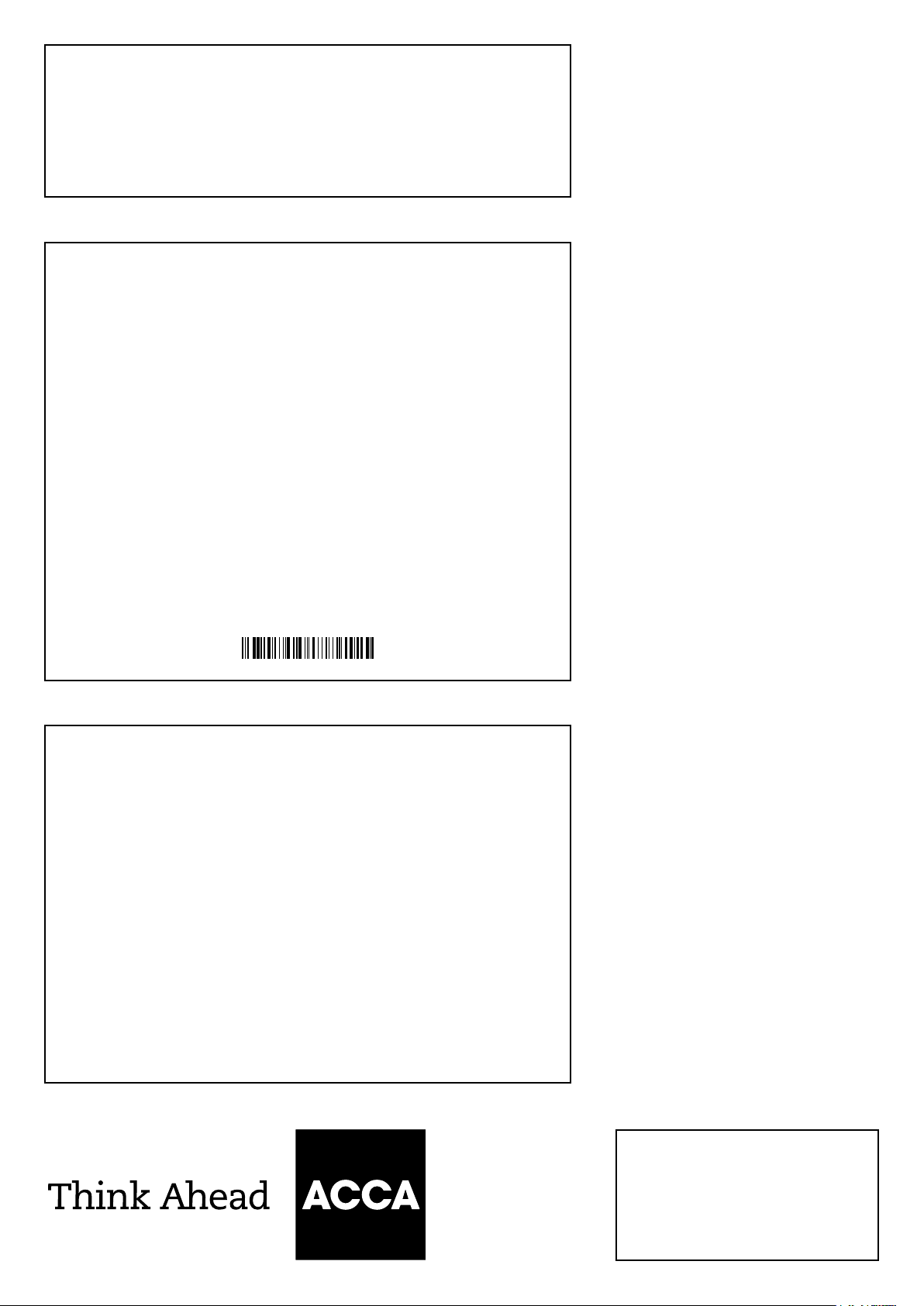
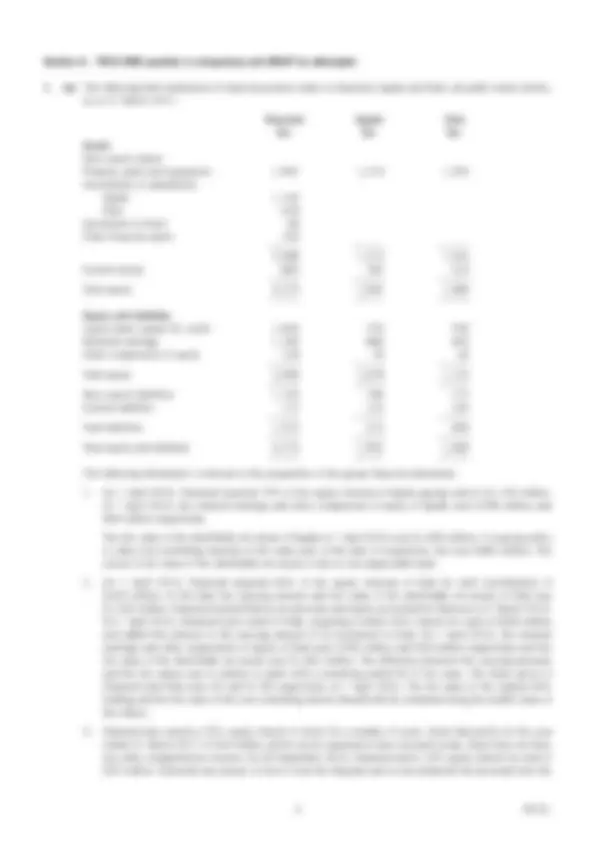
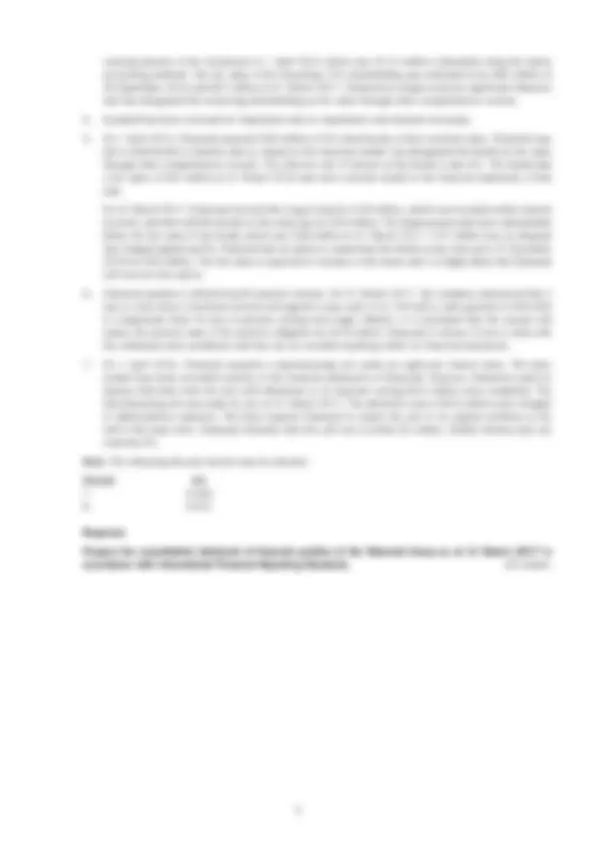
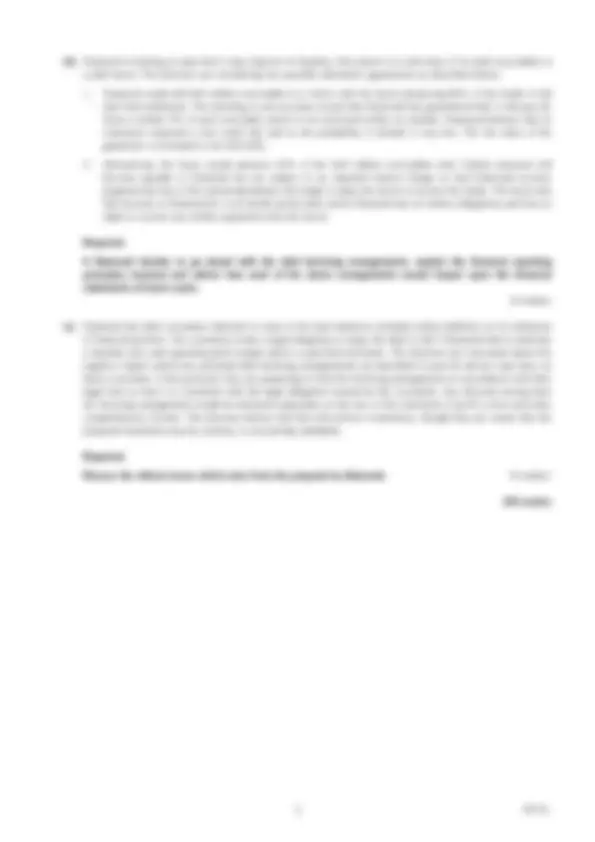
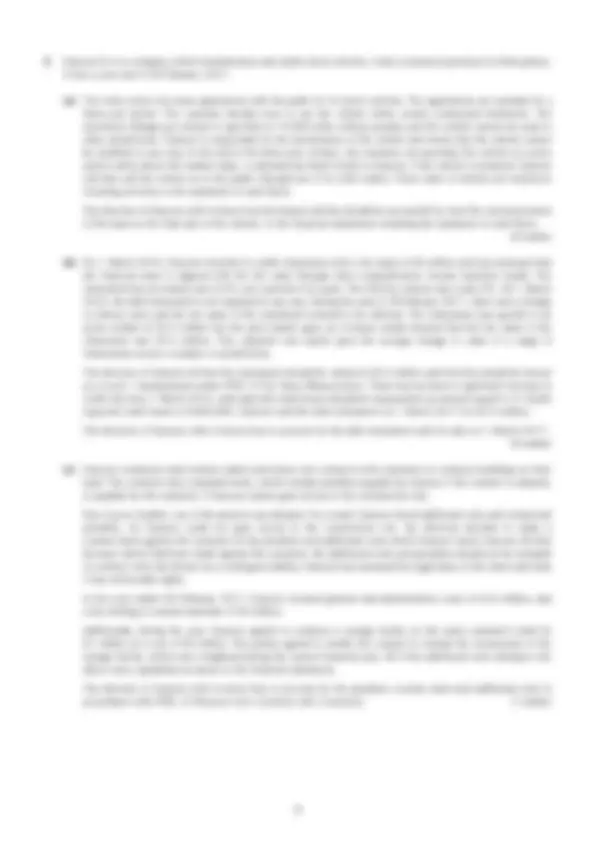

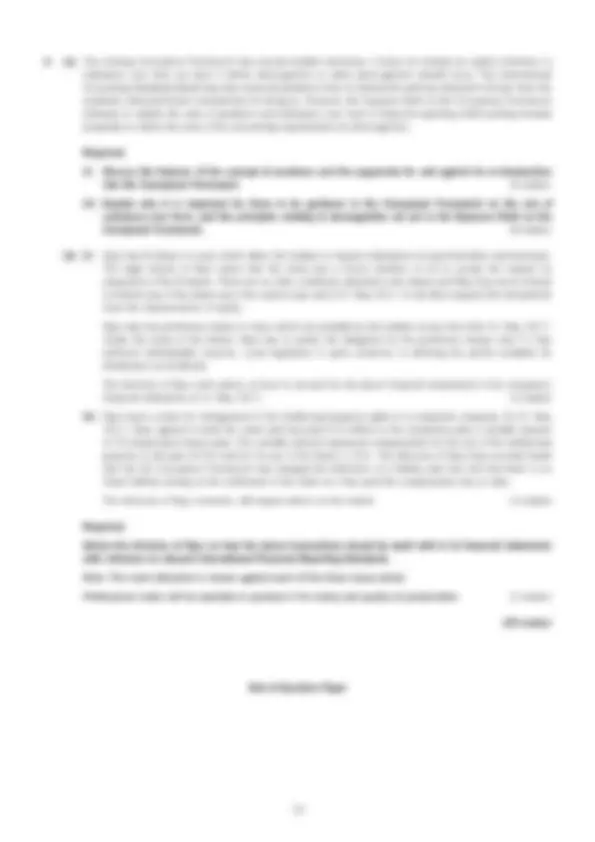


Study with the several resources on Docsity

Earn points by helping other students or get them with a premium plan


Prepare for your exams
Study with the several resources on Docsity

Earn points to download
Earn points by helping other students or get them with a premium plan
Community
Ask the community for help and clear up your study doubts
Discover the best universities in your country according to Docsity users
Free resources
Download our free guides on studying techniques, anxiety management strategies, and thesis advice from Docsity tutors
Paper P. 2. (IN. T). Corporate Reporting. (International). March/June 2017 – Sample Questions. The Association of. Chartered Certified. Accountants ...
Typology: Study notes
1 / 10

This page cannot be seen from the preview
Don't miss anything!







Time allowed: 3 hours 15 minutes
This question paper is divided into two sections:
Section A – This ONE question is compulsory and MUST be attempted
Section B – TWO questions ONLY to be attempted
Do NOT open this question paper until instructed by the supervisor.
This question paper must not be removed from the examination hall.
Corporate Reporting
(International)
March/June 2017 – Sample Questions
This is a blank page. The question paper begins on page 3.
carrying amount of the investment at 1 April 2016 which was $110 million (calculated using the equity accounting method). The fair value of the remaining 15% shareholding was estimated to be $65 million at 30 September 2016 and $67 million at 31 March 2017. Diamond no longer exercises significant influence and has designated the remaining shareholding as fair value through other comprehensive income.
Note: The following discount factors may be relevant:
Periods 6% 7 0· 8 0·
Required:
Prepare the consolidated statement of financial position of the Diamond Group as at 31 March 2017 in accordance with International Financial Reporting Standards. (35 marks)
(b) Diamond is looking at ways that it may improve its liquidity. One option is to sell some of its trade receivables to a debt factor. The directors are considering two possible alternative agreements as described below:
Required: If Diamond decides to go ahead with the debt factoring arrangements, explain the financial reporting principles involved and advise how each of the above arrangements would impact upon the financial statements of future years. (9 marks)
(c) Diamond has debt covenants attached to some of the loan balances included within liabilities on its statement of financial position. The covenants create a legal obligation to repay the debt in full if Diamond fails to maintain a liquidity ratio and operating profit margin above a specified minimum. The directors are concerned about the negative impact which any potential debt factoring arrangements (as described in part (b) above) may have on these covenants. If they proceed, they are proposing to treat the factoring arrangements in accordance with their legal form so that it is consistent with the legal obligation created by the covenants. Any discount arising from the factoring arrangement would be disclosed separately on the face of the statement of profit or loss and other comprehensive income. The directors believe that this will achieve consistency, though they are aware that the proposed treatment may be contrary to accounting standards.
Required: Discuss the ethical issues which arise from the proposal by Diamond. (6 marks)
(50 marks)
The pre-tax discount rate for the CGU is 8% and the post-tax discount rate is 6%. Canto has no plans to expand the capacity of the CGU and believes that a reorganisation would bring cost savings but, as yet, no plan has been approved. The directors of Canto need advice as to whether the CGU’s value is impaired. The following extract from a table of present value factors has been provided. Year Discount rate 6% Discount rate 8% 1 0·9434 0· 2 0·8900 0· 3 0·8396 0· 4 0·7921 0· 5 0·7473 0·6806 (8 marks)
Required:
Advise the directors of Canto on how the above transactions should be dealt with in its financial statements with reference to relevant International Financial Reporting Standards.
Note: The mark allocation is shown against each of the three issues above.
Professional marks will be awarded in question 2 for clarity and quality of presentation. (2 marks)
(25 marks)
3 Carsoon Co is a company which manufactures and retails motor vehicles. It also constructs premises for third parties. It has a year end of 28 February 2017.
(a) The entity enters into lease agreements with the public for its motor vehicles. The agreements are normally for a three-year period. The customer decides how to use the vehicle within certain contractual limitations. The maximum mileage per annum is specified at 10,000 miles without penalty and the vehicle cannot be used in other jurisdictions. Carsoon is responsible for the maintenance of the vehicle and insists that the vehicle cannot be modified in any way. At the end of the three-year contract, the customer can purchase the vehicle at a price which will be above the market value, or alternatively hand it back to Carsoon. If the vehicle is returned, Carsoon will then sell the vehicle on to the public through one of its retail outlets. These sales of vehicles are treated as investing activities in the statement of cash flows. The directors of Carsoon wish to know how the leased vehicles should be accounted for, from the commencement of the lease to the final sale of the vehicle, in the financial statements including the statement of cash flows. (8 marks)
(b) On 1 March 2016, Carsoon invested in a debt instrument with a fair value of $6 million and has assessed that the financial asset is aligned with the fair value through other comprehensive income business model. The instrument has an interest rate of 4% over a period of six years. The effective interest rate is also 4%. On 1 March 2016, the debt instrument is not impaired in any way. During the year to 28 February 2017, there was a change in interest rates and the fair value of the instrument seemed to be affected. The instrument was quoted in an active market at $5·3 million but the price based upon an in-house model showed that the fair value of the instrument was $5·5 million. This valuation was based upon the average change in value of a range of instruments across a number of jurisdictions. The directors of Carsoon felt that the instrument should be valued at $5·5 million and that this should be shown as a Level 1 measurement under IFRS 13 Fair Value Measurement. There has not been a significant increase in credit risk since 1 March 2016, and expected credit losses should be measured at an amount equal to 12-month expected credit losses of $400,000. Carsoon sold the debt instrument on 1 March 2017 for $5·3 million. The directors of Carsoon wish to know how to account for the debt instrument until its sale on 1 March 2017. (8 marks)
(c) Carsoon constructs retail vehicle outlets and enters into contracts with customers to construct buildings on their land. The contracts have standard terms, which include penalties payable by Carsoon if the contract is delayed, or payable by the customer, if Carsoon cannot gain access to the construction site. Due to poor weather, one of the projects was delayed. As a result, Carsoon faced additional costs and contractual penalties. As Carsoon could not gain access to the construction site, the directors decided to make a counter-claim against the customer for the penalties and additional costs which Carsoon faced. Carsoon felt that because claims had been made against the customer, the additional costs and penalties should not be included in contract costs but shown as a contingent liability. Carsoon has assessed the legal basis of the claim and feels it has enforceable rights. In the year ended 28 February 2017, Carsoon incurred general and administrative costs of $10 million, and costs relating to wasted materials of $5 million. Additionally, during the year, Carsoon agreed to construct a storage facility on the same customer’s land for $7 million at a cost of $5 million. The parties agreed to modify the contract to include the construction of the storage facility, which was completed during the current financial year. All of the additional costs relating to the above were capitalised as assets in the financial statements. The directors of Carsoon wish to know how to account for the penalties, counter claim and additional costs in accordance with IFRS 15 Revenue from Contracts with Customers. (7 marks)
4 (a) The existing Conceptual Framework has several notable omissions. It does not include an explicit reference to substance over form nor does it define derecognition or when derecognition should occur. The International Accounting Standards Board has also removed prudence from its framework and has attracted criticism from the academic and practitioner communities for doing so. However, the Exposure Draft on the Conceptual Framework attempts to explain the roles of prudence and substance over form in financial reporting whilst putting forward proposals to clarify the aims of the accounting requirements for derecognition.
Required: (i) Discuss the features of the concept of prudence and the arguments for and against its re-introduction into the Conceptual Framework****. (6 marks) (ii) Explain why it is important for there to be guidance in the Conceptual Framework on the role of substance over form, and the principles relating to derecognition set out in the Exposure Draft on the Conceptual Framework****. (8 marks)
(b) (i) Skye has B shares in issue which allow the holders to request redemption at specified dates and amounts. The legal charter of Skye states that the entity has a choice whether or not to accept the request for repayment of the B shares. There are no other conditions attached to the shares and Skye has never refused to redeem any of the shares up to the current year end of 31 May 2017. In all other respects the instruments have the characteristics of equity. Skye also has preference shares in issue which are puttable by the holders at any time after 31 May 2017. Under the terms of the shares, Skye has to satisfy the obligation for the preference shares only if it has sufficient distributable reserves. Local legislation is quite restrictive in defining the profits available for distribution as dividends. The directors of Skye wish advice on how to account for the above financial instruments in the company’s financial statements at 31 May 2017. (5 marks) (ii) Skye faces a claim for infringement of the intellectual property rights of a competitor company. On 31 May 2017, Skye agreed to settle the claim and has paid $15 million to the competitor plus a variable amount of 2% based upon future sales. The variable amount represents compensation for the use of the intellectual property in the past (0·5%) and for its use in the future (1·5%). The directors of Skye have recently heard that the ED Conceptual Framework has changed the definition of a liability and now feel that there is no future liability arising on the settlement of the claim as it has paid the compensation due to date. The directors of Skye, however, still require advice on the matter. (4 marks)
Required: Advise the directors of Skye on how the above transactions should be dealt with in its financial statements with reference to relevant International Financial Reporting Standards. Note: The mark allocation is shown against each of the three issues above. Professional marks will be awarded in question 4 for clarity and quality of presentation. (2 marks)
(25 marks)
End of Question Paper